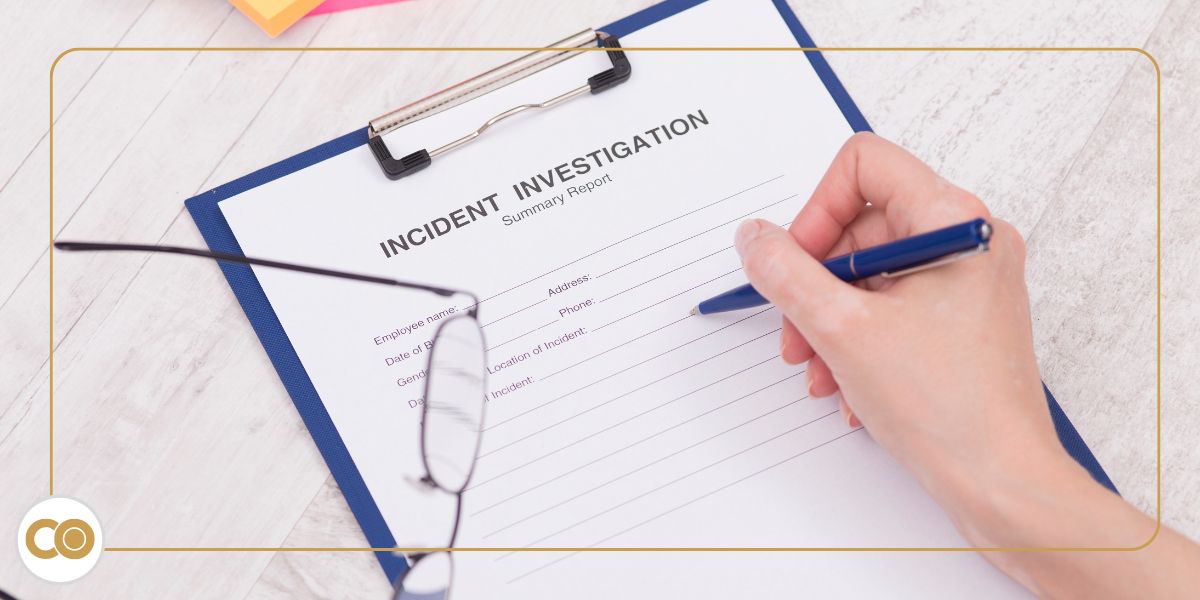SB 553 Compliance: The Violent Incident Log Requirement
April 25th, 2024 | 6 min. read

Have you ever watched the ‘Tell All’ episode of a reality TV show? The post-airing segment where all of the stars return to set and reveal what really happened behind the scenes to deliver Emmy-nominated arguments to your screen. Suddenly, the on-camera drama makes a lot more sense.
What if there was a ‘Tell All’ following incidents of violence in your workplace, offering a peek into the hidden dynamics that fuel at-work flare-ups?
Just think of how these insights could help you address and prevent the causes of workplace violence.
With the introduction of California’s Senate Bill 553 (SB 553), there actually is!
As part of this new legislation, effective July 1st, 2024, businesses must maintain a detailed Violent Incident Log. This log is not merely a record; it's a critical tool to 'Tell All' about workplace incidents. As a tool used to thoroughly document violent incidents – from breakroom ballistics to on-the-job outbursts – it enables employers to understand the underlying causes of workplace violence and take proactive measures to prevent them.
But what exactly does this mean for your business?
To comply, you will have to follow strict and specific reporting guidelines which include retrieving, recording, and regularly reviewing details of every violent incident that occurs in your workplace.
This article is going to provide you with step-by-step instructions on how to maintain a Violent Incident Log that complies with the requirements of SB 553. By reading it, you’ll be equipped to turn this new regulatory requirement into a valuable resource for improving workplace safety.
Understanding SB 553: A legislative response to a growing concern
Workplace violence is a growing concern, with statistics highlighting a staggering 2 million workplace assaults occurring annually according to the Occupational Safety and Health Administration (OSHA). SB 553 serves as a targeted legislative response, aiming to strengthen protections for employees and foster safer work environments.
At the heart of this initiative lies the Workplace Violence Prevention Plan (WVPP), a comprehensive strategy mandated by SB 553. This plan equips businesses with a proactive approach to preventing violence and ensuring employee well-being.
Need more information on SB 553 and how to comply with the WVPP requirement? Register to attend our FREE webinar to learn the ins and outs of this new legislation.
The purpose of your WVPP Violent Incident Log
A critical component of the WVPP is the Violent Incident Log requirement. By documenting violence, businesses can more easily identify causes and develop strategies to mitigate future risks.
The Violent Incident Log is not just a box to check for compliance. It's a powerful tool that empowers businesses to leverage past incident information to create a safer work environment.
Here's how it serves as the foundation for a data-driven approach to preventing workplace violence.
Documentation for compliance
Maintaining a comprehensive log ensures all incidents are recorded in accordance with SB 553. This documented record becomes crucial during regulatory audits and inspections, demonstrating your adherence to the legislation.
Tool for investigation
A meticulous Violent Incidence Log ensures a thorough investigation of each incident. Recording details like the date, time, and nature of the violence provides valuable insights. This information helps identify contributing factors and potential correlations between incidents.
Foundation for prevention
The true power of the Violent Incident Log lies in its ability to inform preventive measures. By analyzing data collected over time, businesses can identify patterns and trends. This knowledge empowers them to develop targeted strategies to prevent future violence.
For instance, if the log reveals a recurring issue of customer aggression towards cashiers, the business could implement de-escalation training for staff or explore security upgrades at checkout areas.
What to include in your WVPP Violent Incident Log
SB 553 outlines specific elements that must be captured in the Violent Incident Log. Understanding these components is essential for accurate and comprehensive documentation.
Here's a breakdown of each key element.
General information:
- Date of incident – Enter the specific date the incident occurred.
- Time of incident – Note the exact timeframe when the violence happened.
- Location of incident – Specify the precise location where the incident occurred.
Workplace violence type:
4 types of workplace violence
Categorize the incident using the following workplace violence classifications defined by the National Institute for Occupational Safety and Health (NIOSH):
- Type #1: Criminal intent – This type of violence involves individuals with no legitimate relationship to the business or its employees. It typically occurs in conjunction with another crime, such as robbery, shoplifting, or trespassing.
- Type #2: Customer/client – This is the most common type of workplace violence. It involves individuals who have a relationship with the business and become violent while receiving services. This can include aggressive behavior due to dissatisfaction with service, conflicts arising during business transactions, or personal grievances directed toward employees.
- Type #3: Worker-on-worker – This type of violence involves employees who attack or threaten another employee. For example, arguments escalating into physical altercations, personal issues spilling over from outside the workplace, and harassment or bullying between colleagues.
- Type #4: Personal relationship – This type involves violence or threat of violence by an individual with a personal relationship to the employee outside of work, that impacts the workplace. This can include violent actions on behalf of an intimate partner, a family member, or even a stalker.
Check out our Learning Center Article for a deep dive on workplace violence, featuring tried and true strategies on how to prevent incidents from occurring in your workplace!
Type of incident
Describe the specific nature of the violence. This should detail whether the violent incident was any of the following:
- Physical attack without a weapon
- Attack with a weapon or object
- Sexual assault or threat
- Animal attack
- Other
Details of involved parties:
- Perpetrator classification – Explain the relationship between the victim and the person who committed the violence. For example, were they a client? A coworker? A stranger?
- Witness statements – Include summaries of witness accounts, maintaining confidentiality by omitting names or other identifying information. This can be achieved by assigning witness numbers for reference during investigations.
Context of the incident:
- Circumstances – Document the situation surrounding the incident including a detailed description of it with additional information on the type of incident. This might include details like staffing levels, whether the employee was alone or with others, whether security personnel or cameras were present, and even lighting conditions.
Response measures:
Initial response
Detail the immediate actions taken to address the incident. This includes details such as:
- Security contact – Confirm whether security or law enforcement was contacted and, if applicable, their response.
- De-escalation actions – Outline any actions taken to de-escalate the situation or evacuate the area. This may include techniques such as verbal persuasion, calming strategies, or, if necessary, physical removal of individuals from the vicinity to ensure safety.
- Medical assistance intervention – Verify if medical help was summoned to care for any injuries sustained during the incident.
Consequences and actions taken
Describe any ongoing measures implemented to mitigate risks. This includes details such as:
- Disciplinary actions – Specify if any disciplinary actions were taken against the offender. This step is crucial for enforcing workplace policies and ensuring accountability.
- Security operations – Describe any increase in security measures or personnel, following the incident. This action will help to enhance the safety of your workplace environment and deter future incidents.
- Temporary safety protocols – Outline temporary safety protocols that have been put in place to prevent the recurrence of similar incidents and secure your workplace in the interim period.
Injury reporting
Note if any injuries resulted from the incident. Additionally, document whether emergency medical services were required or if injuries need to be reported to regulatory bodies like Cal/OSHA.
Investigation and recordkeeping:
Investigation findings
Summarize the key findings from the investigation into the incident. This might include information gathered from employees involved, witness accounts, security footage, or other relevant sources.
Corrective actions implemented
Outline any corrective actions taken to prevent future incidents of a similar nature. These actions could involve:
- Updating training programs – Enhanced workplace violence prevention and de-escalation training to better equip employees with the skills they need to handle potential threats.
- Addressing security vulnerabilities – Necessary adjustments to the workplace layout to eliminate security weak points and enhance overall safety.
- Revising customer interaction protocols – Strengthen protocols for managing customer interactions and cash handling processes to reduce the risk of conflict and ensure safer transactions.
Record duration
State how long these records will be maintained according to your organization's policy and any relevant legal requirements. In most cases, records should be kept for a minimum of five years.
Log maintenance:
- Log format – There's no mandated format for the log. Businesses can choose a paper-based system, a digital spreadsheet, or specialized software. The key is to ensure the chosen format is secure, accessible to authorized personnel, and easy to maintain.
- Log completion – Document who completed the log entry, their job title, and the date of completion. Additionally, include a signature line for the person completing the log.
- Log confidentiality – Ensure that all personally identifying information of the individuals involved is omitted from the log. This includes names, addresses, social security numbers, medical information, or any other details that could be used to identify them.
- Log review – Evaluate the log to identify trends and areas where preventative measures can be implemented. Utilize these reviews to update safety protocols and training programs.
Beyond compliance: Take the next steps to prevent violence in your workplace
You now have the tools to not just meet SB 553's requirements but to transform them into a proactive force for uncovering and addressing risks of workplace violence.
Need more information about compliance with SB 553? No problem!
By following the steps outlined in this article you’ll be able to set up your WVPP Violent Incident Log, keep it compliant, regularly analyze the entries, and use each report to prevent future violent incidents from happening.
Need expert assistance with this process?
Our expert HR team can help! Whether it’s crafting a customized WVPP for your business or providing you with the templates for your Violent Incident Log, we are committed to helping you create a culture of compliance and workplace safety.

|
Are you ready to lead the charge toward workplace safety? |
This article is not intended to be exhaustive nor should any discussion or opinions be construed as legal advice. Readers should contact legal counsel for legal advice.
.png?width=1125&height=426&name=Your%20paragraph%20text%20(5).png)



